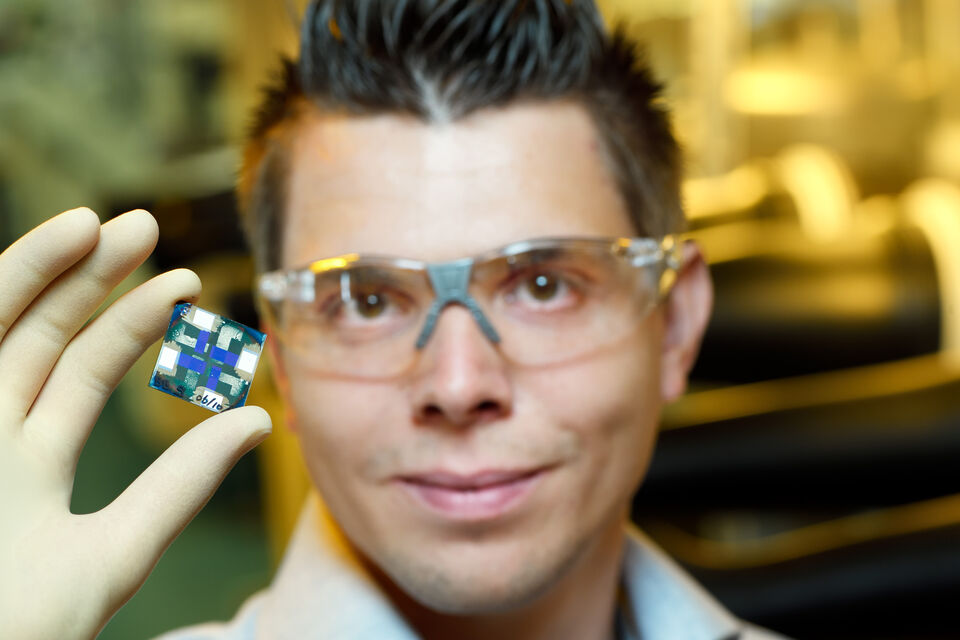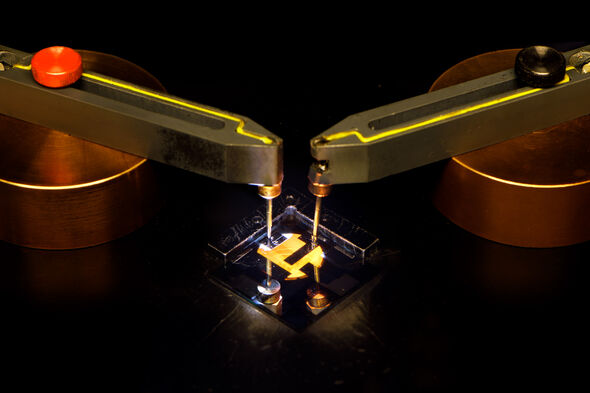Home Stretch | Pioneering with perovskite
They are ‘hot’ in the world of solar cells: perovskite crystals have the potential to combine the benefits of conventional silicon cells (high efficiency) and plastic solar cells (cheap, thin and flexible). Bardo Bruijnaers was the first Eindhoven PhD candidate allowed to throw himself into this new technology.
Perovskite is the name of a mineral discovered in the nineteenth century by the German mineralogist Gustav Rose in the Urals and named for his Russian colleague Lev Perovski. But Rose could not have suspected that almost two centuries later the term perovskite would become synonymous with a revolution in solar cell research.
Materials with the same crystal structure - but not the same composition - as natural perovskite have proven to be almost as efficient as the well-known silicon cell, and offer the additional benefit that they can be produced from a solution in thin layers. So thin in fact that they can form the basis for flexible solar cells. Furthermore, by choosing different atoms as the building blocks for the crystals, you can experiment with which part of the solar spectrum is absorbed.
Ten a day
The flight taken by research into perovskite is evident from a diagram in Bardo Bruijnaers' PhD thesis. In 2009 only three scientific articles were published on perovskite-based solar cells whereas last year that number had risen to just under three thousand. “That is almost ten a day,” says the doctoral candidate. “At a certain point I simply stopped keeping track of all the literature, it was no longer worthwhile.”
In 2014 Bruijnaers, who having completed a vocational higher education degree spent two years working as an analyst before deciding to study for a Master's in Chemical Engineering at TU/e, became the first PhD candidate in the group led by university professor and Spinoza laureate René Janssen to be given the go-ahead to study perovskite. Janssen was already a world expert in the field of plastic solar cells, in which sunlight is converted to electricity using polymers, but he foresaw that for many applications this class of solar cell would have no future in the face of competition from silicon cells, which were rapidly dropping in price. Good reason for Janssen to start up a research line on perovskite in his group.
Unpredictability
“When I started, we didn't yet know anything about perovskite,” tells Bruijnaers. “Of course, there was a lot of useful knowledge about cells based on polymers, but it proved difficult to reproduce the best-performing perovskite cells of the day. They had an efficiency of some 10 percent.”
Among the difficulties encountered was the fact that the cells behaved unpredictably when being measured. If the cells were not entirely perfect, they contained many mobile ions, and the measurement voltage caused them to go walkabout. “So we first studied how you should characterize cells with this imperfection. We did not publish our findings because we did not conisder this to be truly innovative science. A little while later a competing group did produce a paper on the topic, and since then our method has become the standard in the field.”
Read on below the photo.
Short-circuiting
The art lies in forming perovskite crystals that allow the solar cell's two electrodes to connect optimally; the electrons released due to sunlight must encounter minimal resistance as they make their way to the electrode. To ensure this, the crystals must not be too small because the electrons experience the boundaries of the crystals as a barrier. But if the crystals are too large, the empty spaces between the crystals present a risk of short-circuiting.
“It turns out that if you use lead acetate to insert the required lead ions into the crystal, you get small crystals whereas if you use lead chloride, you get crystals that are too large,” says Bruijnaers. A mixture of the two gives the best result, he discovered.
All in all he achieved an efficiency of about 15 percent, while the world record for his type of perovskite cell is now some 20 percent. So there is plenty still to do, if only because it would be preferable not to market a lead-based product. “Opinions are divided about exactly how harmful the lead in these solar cells is, but instead of lead we would rather use, say, tin. But doing that greatly reduces the yield.” It is also debatable how well the crystals can tolerate outdoor conditions. “In any event the cells will need a protective coating.”
Multinational
What began with Bruijnaers as a lonely doctoral candidate has now expanded into a serious perovskite team, with another three PhD candidates, a postdoc and various students. So who knows what we can expect in the coming years in the field of this new solar technology. But the man from Limburg will not be personally involved in these further developments: he is going in search of a job in industry. “As a researcher, preferably in a large company. I have already worked for a family business and here at the university, so I am keen to find out what it is like to work for a multinational.”



Discussion